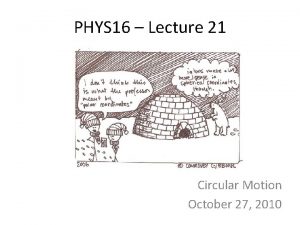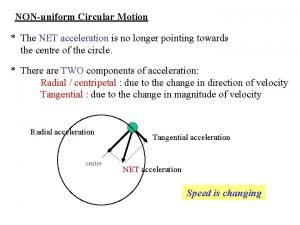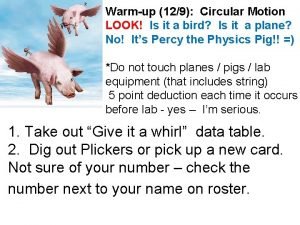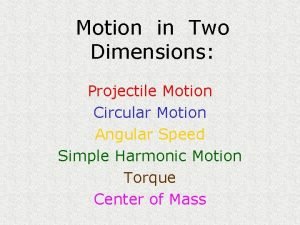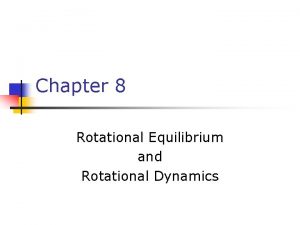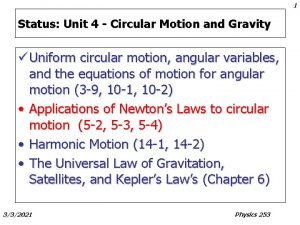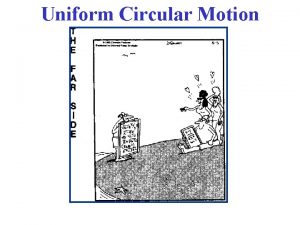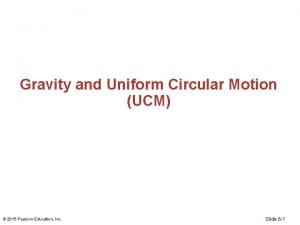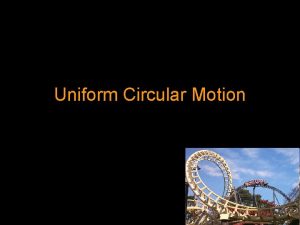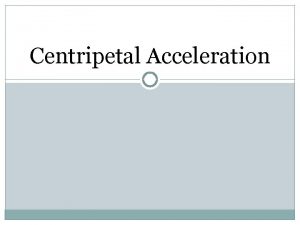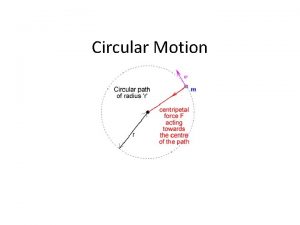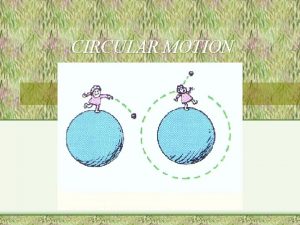Rotational Motion Angular Acceleration In uniform circular motion

![Angular Acceleration ] In uniform circular motion there is a constant radial acceleration. • Angular Acceleration ] In uniform circular motion there is a constant radial acceleration. •](https://slidetodoc.com/presentation_image_h2/963353197a7204115791c20cb90330c5/image-2.jpg)
![The Effect of Torque ] A tangential force on a mass creates an acceleration. The Effect of Torque ] A tangential force on a mass creates an acceleration.](https://slidetodoc.com/presentation_image_h2/963353197a7204115791c20cb90330c5/image-3.jpg)
![Rotational Law of Acceleration ] The force law can be combined with rotational motion. Rotational Law of Acceleration ] The force law can be combined with rotational motion.](https://slidetodoc.com/presentation_image_h2/963353197a7204115791c20cb90330c5/image-4.jpg)
![Torque and Work ] A force does work on an object acting over a Torque and Work ] A force does work on an object acting over a](https://slidetodoc.com/presentation_image_h2/963353197a7204115791c20cb90330c5/image-5.jpg)
![Rotational Work-Energy ] The net work done by forces on an object equals the Rotational Work-Energy ] The net work done by forces on an object equals the](https://slidetodoc.com/presentation_image_h2/963353197a7204115791c20cb90330c5/image-6.jpg)
![Rotational Power ] As with translational motion, power is the rate of work done. Rotational Power ] As with translational motion, power is the rate of work done.](https://slidetodoc.com/presentation_image_h2/963353197a7204115791c20cb90330c5/image-7.jpg)
![Rotation and Translation ] A rolling wheel is moving forward with kinetic energy. ] Rotation and Translation ] A rolling wheel is moving forward with kinetic energy. ]](https://slidetodoc.com/presentation_image_h2/963353197a7204115791c20cb90330c5/image-8.jpg)
![Rolling Energy ] The energy of a rolling wheel is due to both the Rolling Energy ] The energy of a rolling wheel is due to both the](https://slidetodoc.com/presentation_image_h2/963353197a7204115791c20cb90330c5/image-9.jpg)
![Energy Conserved ] A change in kinetic energy is due to work done on Energy Conserved ] A change in kinetic energy is due to work done on](https://slidetodoc.com/presentation_image_h2/963353197a7204115791c20cb90330c5/image-10.jpg)
- Slides: 10

Rotational Motion
![Angular Acceleration In uniform circular motion there is a constant radial acceleration Angular Acceleration ] In uniform circular motion there is a constant radial acceleration. •](https://slidetodoc.com/presentation_image_h2/963353197a7204115791c20cb90330c5/image-2.jpg)
Angular Acceleration ] In uniform circular motion there is a constant radial acceleration. • ar = v 2 / r = rw 2 ] The angular acceleration is a If the angular velocity changes there is acceleration tangent to the circle as well as radially.
![The Effect of Torque A tangential force on a mass creates an acceleration The Effect of Torque ] A tangential force on a mass creates an acceleration.](https://slidetodoc.com/presentation_image_h2/963353197a7204115791c20cb90330c5/image-3.jpg)
The Effect of Torque ] A tangential force on a mass creates an acceleration. • Tangential force: Ft = m at • Tangential acceleration: at = ra ] The force is associated with a torque. • Torque: t = r Ft m
![Rotational Law of Acceleration The force law can be combined with rotational motion Rotational Law of Acceleration ] The force law can be combined with rotational motion.](https://slidetodoc.com/presentation_image_h2/963353197a7204115791c20cb90330c5/image-4.jpg)
Rotational Law of Acceleration ] The force law can be combined with rotational motion. • Torque: t = r Ft = r m at = m r 2 a ] If torque replaces force, and angular acceleration replaces acceleration, this looks like the law of acceleration.
![Torque and Work A force does work on an object acting over a Torque and Work ] A force does work on an object acting over a](https://slidetodoc.com/presentation_image_h2/963353197a7204115791c20cb90330c5/image-5.jpg)
Torque and Work ] A force does work on an object acting over a distance. ] A torque does work on an object rotating through an angle. r Dq
![Rotational WorkEnergy The net work done by forces on an object equals the Rotational Work-Energy ] The net work done by forces on an object equals the](https://slidetodoc.com/presentation_image_h2/963353197a7204115791c20cb90330c5/image-6.jpg)
Rotational Work-Energy ] The net work done by forces on an object equals the change in kinetic energy. ] The net work done by torques on an object equals the change in rotational kinetic energy.
![Rotational Power As with translational motion power is the rate of work done Rotational Power ] As with translational motion, power is the rate of work done.](https://slidetodoc.com/presentation_image_h2/963353197a7204115791c20cb90330c5/image-7.jpg)
Rotational Power ] As with translational motion, power is the rate of work done. ] The earth is slowing due to the tides. • About 28 s / century • 1 part in 108 ] The kinetic energy is changing. ] The power dissipation is large: • About 7 billion hp
![Rotation and Translation A rolling wheel is moving forward with kinetic energy Rotation and Translation ] A rolling wheel is moving forward with kinetic energy. ]](https://slidetodoc.com/presentation_image_h2/963353197a7204115791c20cb90330c5/image-8.jpg)
Rotation and Translation ] A rolling wheel is moving forward with kinetic energy. ] A rolling wheel is rotating with kinetic energy. ] The velocity is measured at the center of mass. ] The axis of rotation is at the center of mass. • Krot = ½ I w 2 • KCM = ½ m v 2 v w
![Rolling Energy The energy of a rolling wheel is due to both the Rolling Energy ] The energy of a rolling wheel is due to both the](https://slidetodoc.com/presentation_image_h2/963353197a7204115791c20cb90330c5/image-9.jpg)
Rolling Energy ] The energy of a rolling wheel is due to both the translation and rotation. ] The velocity is linked to the angular velocity. ] The effective energy is the same as a wheel rotating about a point on its edge. • Parallel axis theorem
![Energy Conserved A change in kinetic energy is due to work done on Energy Conserved ] A change in kinetic energy is due to work done on](https://slidetodoc.com/presentation_image_h2/963353197a7204115791c20cb90330c5/image-10.jpg)
Energy Conserved ] A change in kinetic energy is due to work done on the wheel. • Work is from a force • Force acts as a torque ] Rolling down an incline the force is from gravity. • Pivot at the point of contact ] The potential energy is converted to kinetic energy. v R F = mg q
 Angular vs linear velocity
Angular vs linear velocity Kinetic angular energy
Kinetic angular energy Circular motion
Circular motion Non uniform circular motion
Non uniform circular motion Formula for centripetal acceleration in circular motion
Formula for centripetal acceleration in circular motion Formula for acceleration in circular motion
Formula for acceleration in circular motion Second condition of equilibrium
Second condition of equilibrium Rotational equilibrium and dynamics
Rotational equilibrium and dynamics Circular motion
Circular motion What is uniform circular motion
What is uniform circular motion Nascar
Nascar


